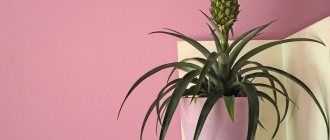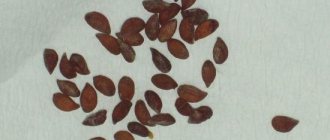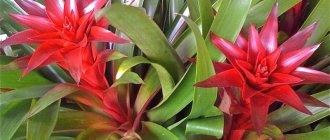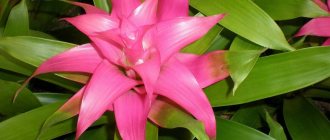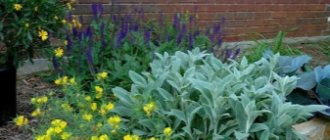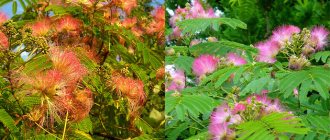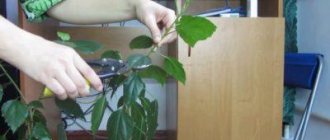Pineapple as a houseplant. The most common species: A. Crested, A. Pritsvetnikovy, A. Variegata, A. Porteanus. Pineapple propagation at home. Transplantation, care.
Pineapple is a genus of 8 species belonging to the Bromeliad family. Habitat: Brazil, Colombia, Paraguay and Venezuela. One species of greatest interest is the Pineapple Large-tufted. This is the only representative of the bromeliad family, the fruits of which are eaten by people. Pineapple is a valuable fruit crop and is cultivated all over the world; it is its fruits that lie on the shelves of our stores.
Pineapple plantation
General description and varieties
The literal translation of the word “pineapple” is the smell of odors. The plant is aptly named. Scientists are still arguing – is pineapple a fruit or a vegetable?
Pineapple is a herbaceous plant. Its prickly leaves are collected in a rosette, in nature they reach a height of 1 meter and are capable of storing moisture. Pineapple flowers are collected in a beautiful compact inflorescence.
In indoor floriculture, pineapples are grown for their beautiful leaves, which, with good care, can reach 70 cm. Flowering in an apartment occurs very rarely. Let's look at the most interesting types of pineapple for indoor floriculture:
1. Crested pineapple - edible, already mentioned above.
Pineapple Crested
2. Pineapple Bract - much more decorative, it has bronze-green leaves with a yellow border.
Pineapple bract with fruit and children
3. Pineapple Variegata has green and cream stripes on the leaves that turn pink in good light.
Pineapple Variegata
4. Pineapple Porteanus - the leaves have yellowish-cream stripes, red along the edges.
Watering an exotic fruit
So, you have become the owner of a plant such as a pineapple in a pot. How to care for it is more or less clear. All that remains is to sort out the watering.
It is known that pineapples usually grow in the tropics, so excess moisture can have a detrimental effect on them. Such a plant should be watered only when the soil in it becomes almost dry. There should be no stagnation of water in the pot.
Flower growers pay special attention to watering. How a pineapple grows in a pot depends not only on temperature and lighting, but also on how well all its conditions are met. So, you should water the pineapple once a week, using water at room temperature, which should either be filtered or allowed to sit for a while.
During the summer, the tropical plant requires more moisture, so it can be watered three times a week. In winter, it is enough to limit yourself to once every two weeks. If an unpleasant odor appears from the pot, it means there is too much moisture. Its redundancy can also be determined by the appearance of mold. If the pineapple leaves begin to dry out, then this is a sign that the plant does not have enough moisture.
If there is a smell or mold in the pot, the pineapple needs to be transplanted into another container, otherwise the plant may die. If the trunk begins to rot, watering should be stopped for a while. If the room where the pineapple is located is well ventilated, then you can stop watering for a while and simply lightly spray the leaves, which will absorb the required amount of moisture, and the rest will simply evaporate.
Transfer
Perhaps the biggest difficulty in caring for a pineapple is replanting. It is produced as needed, if the plant is clearly cramped in an old pot and only by transshipment. Pineapples don't like to be disturbed.
If you cannot do without a transplant, do it as carefully as possible. Take a wide shallow pot (pineapple has a shallow root system), pour fine expanded clay on the bottom, and a 3 cm thick layer of soil on top. You must remove the plant from the old pot very carefully, trying not to collapse the earthen ball. Place the pineapple in a new container and cover it with fresh soil so that there is no difference between the level of fresh soil and the top layer of soil of the overloaded plant. Carefully press the new soil with your fingers and add 2-3 cm.
Planting a pineapple
What to do after buying a plant
Transporting a small bush from the store must be done with caution . The tropical guest is extremely sensitive to low temperatures. In the cold season, it is necessary to carefully wrap the pot with the plant with any insulating material and pack it in a cardboard box.
At home, the plant must be quarantined for 2 weeks . This is necessary both to identify possible diseases and to adapt the exotic to new conditions.
After this, the specimen needs to be transplanted. The transplant procedure is necessary. The store container is not intended for the full development of the plant. It is better to choose a container made of clay or ceramics, with drainage holes so that the roots can breathe. A low and wide pot up to 1 liter in size will do.
The soil mixture can be purchased at the store. Suitable soil for cacti or citrus plants. If the soil is prepared independently, then peat, sand, turf soil, and humus are taken in a ratio of 3: 1: 3: 2 . Everything is thoroughly mixed. Drainage from pebbles, brick chips, and expanded clay is poured into the pot ¼ full. Then a layer of new soil.
The specimen is carefully removed from the container and, together with the earthen lump, transferred to a new pot. The remaining soil is poured on top, carefully compacted and watered.
Pests and diseases
Pineapples are rarely damaged by diseases and pests, but they do occur.
False scale insect - any infected plant was brought into the house. The pest moves very slowly and was most likely transferred to the pineapple by humans or animals through direct contact. In the initial stage, you can remove the false scale insect with a cotton swab soaked in alcohol. Treat the pineapple with a solution of karbofos or a weak solution of potassium manganese. If there are a lot of pests, the plant will have to be thrown away - it is completely impossible to get them out of the leaf axils, and repeated spraying with karbofos will not bring anything good to either the pineapple or your family.
Fungal infection - most likely the pineapple was watered into an outlet. This cannot be done. If the disease is in its early stages, try treating the pineapple with a fungicide. If the core rots, the plant cannot be saved.
Possible problems
1. The tips of the pineapple leaves dry out - dry air. Spray the plant, increase the humidity.
2. Mold on a pineapple pot or on the soil - excessive watering in winter. Give the plant less moisture. Gently wipe off the mold from the pineapple pot with a clean cloth.
3. Root rotting - excess moisture at low temperatures. Cut off and root the top of the pineapple.
4. Slow growth - cold water and air, or lack of nitrogen. Feed the pineapple, heat the water for irrigation, increase the room temperature.
Pineapple propagation
Reproduction of pineapple by apical rosette
Propagation of pineapple in itself is a fascinating business. It occurs either by planting an apical rosette, cut off along with part of the fruit, or by children growing after fruiting. The first method of pineapple propagation is easier, the second is reliable.
So, we propagate pineapple with an apical rosette. Most often we use store-bought fruit. The problem is that the top of a fresh pineapple will take root well. You can't be sure of either one. Select a pineapple with fresh, firm leaves and no damage or rot. By the way, the top of an unripe pineapple takes root better.
Carefully cut off the top of the selected fruit. Sprinkle the cut area with crushed activated carbon tablets to prevent the pineapple from rotting. Leave for 4-7 days for calus to form in a dark place. Then take a shallow wide pot and fill it with the same soil as for replanting a pineapple. Press the prepared top into the substrate 3 cm. Cover with a jar or other transparent container to maintain moisture. If everything goes well, the pineapple will root after one and a half to two months.
To propagate by children, wait until the pineapple sprouts reach a size of 15-20 cm, carefully break them out and plant them in small pots. High humidity must be maintained. For successful rooting of pineapple, both apical cuttings and children, it is necessary to maintain a temperature of 25-30 degrees.
Planting a pineapple top
One way to plant a pineapple is to sprout its top, which resembles a crown with its leaves. It can be separated from the fruit in different ways. The first way, for example, is to carefully grasp the pineapple leaves with your hand and gradually turn them out as if you were opening a bottle. As a result, the upper part of the plant, which is the foliage with a stem that is small and dense, will easily separate from the pulp.
The second way to separate the top for planting is to carefully cut off the green rosette along with two centimeters of the fruit itself. Then it remains to use a knife to remove the remaining pulp, which causes rotting.
Preparing to plant the top of a pineapple in a pot requires a careful and thorough inspection of the entire plant.
- If small white dots are visible near the base, you should protect them. It is from these that the roots of the fruit will grow in the future. So, for example, you need to tear off the lower leaves from the rosette, but you should do this perpendicular to the stem so as not to damage the small roots.
- If there are cuts on the stem, they must be processed so that this place does not fester and so that the roots germinate faster. Most often, charcoal, potassium permanganate solution or epin are used for processing.
There is no need to plant the top of the pineapple into the soil right away. First, you should leave it for a few days to dry it out. This is necessary to prevent the plant from rotting. It is best to hang the pineapple top prepared for planting for a while so that the cut does not touch anything. And then the tuft should be placed in a glass container with water so that the entire bare stem is covered with liquid. It is necessary to fix the top so that it does not move.
The pineapple top should stand in water until the roots appear. To do this, place the container with water where it will be lowered in a bright place and change the water every two days. Usually the roots sprout within two weeks, and then the plant can be replanted in a pot. But before planting, you should leave the rosette on a paper towel for several hours so that it dries slightly.
Flowering and fruiting
Pineapple flower
Know that if you grow a pineapple in an apartment, most likely you will not see any flowering or fruiting of your pet. Enjoy the beautiful leaves and proudly tell your guests that this pretty bromeliad plant is a pineapple. True, anything can happen. Perhaps you will be lucky. And if the pineapple has already bloomed, most likely, fruits will also form.
Flowering lasts up to 2 weeks. It can occur either in May-July or in December. Sometimes it is recommended to place apples next to it to stimulate pineapple flowering. The fruit ripens in about 4 months.
Pineapple will probably bloom and bear fruit only in a greenhouse or conservatory.
Proper care at home
Caring for a tropical plant must be approached with the utmost responsibility. A florist who decides to grow an exotic crop in an apartment must create comfortable conditions for its healthy development.
Location
The first thing you should think about is a good location. Pineapple needs a lot of heat and a lot of sun. The ideal placement option is a south or southeast window .
If this is not possible, you should place the bush in the brightest place in the house. You need to keep the pot with the plant away from drafts and the drying effects of heating devices.
Lighting
When placing a new tenant, do not forget about the “neighbors”. The spread of pineapple leaves will certainly not be the same as in the wild, but 0.6 m in diameter. Therefore, it requires individual placement away from other indoor plants. The sun is a pineapple's best friend. It prefers bright lighting and can withstand direct sunlight well.
The need for shading arises if the thermometer does not drop below +35°C . In such conditions, even a southerner can feel bad. Long daylight hours, at least 10 hours, are the key to active vegetation and a beautiful appearance for your green pet.
Deprived of light, a pineapple may never bloom, let alone bear fruit. If there is a lack of lighting, especially in the autumn-winter period, the plant is extended daylight hours with fluorescent lamps.
Air temperature and humidity
The tropical specimen is very thermophilic. For full development, the temperature in the room should be from +22°C to +26°C . On warm summer days, you can take the pot with the plant to the terrace, balcony, or garden. Fresh air will do you good. At night, the pot must be removed indoors. Pineapple is very afraid of lower temperatures, this can damage the root system.
A winter decrease in temperature by a few degrees will not harm the plant; on the contrary, it will make it easier to tolerate the reduction in daylight hours. You just need to make sure that the lower readings do not fall below +17°C +18°C .
A native of hot countries does not have high requirements for air humidity. The acceptable norm for him is 55-60% . However, if the house is too hot, you should periodically mist the plant and wash it in a warm shower.
Soil composition
To make your exotic pet feel comfortable, you need to choose the right soil. It should be loose, nutritious, with good breathability. From store-bought options, a soil mixture for bromeliads or orchids is suitable. When choosing a different store-bought soil, you need to inquire about the level of the environment. Pineapple prefers slightly acidic soil with a pH value of 4.5-5 .
If the grower prepares the substrate himself, you will need:
- Coarse sand – 1 part.
- Chopped peat - 3 parts.
- Pine bark – 1 part.
- Sod land - 3 parts.
- Humus - 2 parts.
For drainage, fine gravel, brick chips, and expanded clay are used.
Proper watering
In summer, the plant should be watered abundantly, but not excessively . A green pet will be able to withstand short-term dryness without damage, but overwatering can cause rotting of the roots. In summer, watering is carried out once a week , provided that the soil is completely dry.
The main rule must be followed - water the pineapple only with warm water . The water temperature should be 10°C higher than the air temperature. Before watering, the water should sit for at least 2 days.
Of course, you shouldn’t forget about spraying and shower procedures. In hot weather they are carried out early in the morning or after sunset. With the onset of the dormant period, watering is reduced. At this time, the decorative specimen absorbs moisture very slowly. 1 watering every 2 weeks is enough .
Top dressing
The tropical pet responds very gratefully to feeding. During the active growing season (spring - summer), the exotic crop must be fed once every 15 days . You can apply purchased organic fertilizers or make your own mullein infusion.
To make an infusion, you need to take a 1 liter jar, fill it ⅓ with manure and top up with water. Leave the mixture for 10 days, stirring occasionally. Then pour into a bucket of water. The result is high-quality fertilizer.
You can feed the plant with complex mineral fertilizers if you don’t want to bother with preparing the infusion. It is important to remember here that you should always dilute mineral fertilizers 2 times weaker than what is written in the instructions.
It is forbidden to feed pineapple with fertilizers containing lime, wood ash or alkali. In the autumn-winter period, the plant does not need feeding.
Rest period
The dormant period begins in October and lasts until March. Exotic crops need to gain strength for the new growing season. At this time, frequent watering is not needed, feeding is stopped. The air temperature can be reduced slightly, but not below +18°C .
It is recommended to reduce the lighting intensity; the light should be dim. However, 10 hours of daylight must be provided, even with the help of artificial lighting.
Trimming
There is no special pruning for pineapple. It forms independently both in nature and at home.
The whole procedure comes down to the timely removal of dried and damaged leaves. In this case, you need to act very carefully so as not to injure healthy leaves. It is better to trim the leaves with sharp garden shears. After each cut, disinfect the blades with an antiseptic.
Transfer
Indoor pineapple should be replanted when the need arises. He doesn't like unnecessary worries. If the roots clearly no longer fit in the old container, then the plant is replanted very carefully and only by transshipment.
It should be replanted in a low, wide container. First, a 2-3 cm layer of drainage is poured onto the bottom, then 3 cm of soil. Carefully remove the specimen from the old container along with the earthen lump. Place in a new pot, straighten the roots and add fresh soil.
Flowering and fruiting
In apartment conditions, it is difficult to predict the flowering time of tropical exotics. It may not bloom at all. But with careful and proper care, there is a chance to see flowering 3-4 years after planting.
Pineapple usually blooms from May to mid-July. Although some specimens bloom in December. Some gardeners recommend placing overripe apples near the pot. Fruits produce ethylene, which speeds up the onset of flowering.
6-14 cm long is formed at the top . It consists of many flowers tightly pressed to the stem. When the ear is finally formed (after 1.5-2 months), the flowers begin to bloom. The flowers open one by one, just for one day. Can be purple, bright blue, pink.
During the flowering period, the entire room is filled with an amazing aroma. Flowering lasts 1 month , after which the fruit begins to set. The fruit takes a long time to form, about 6 months . The weight of a fetus ripened at home rarely exceeds 1 kg .
